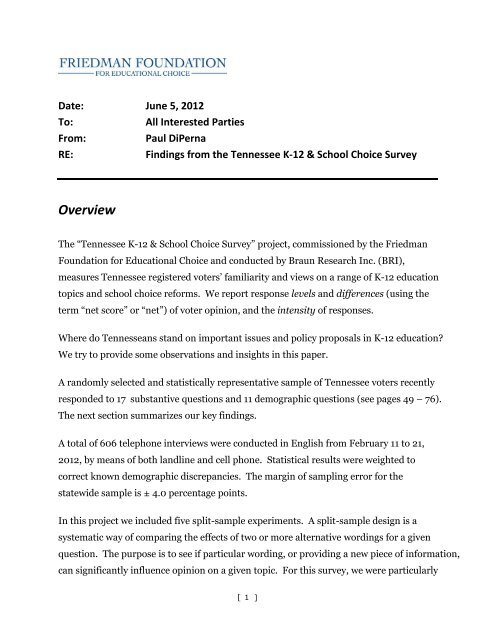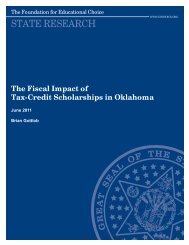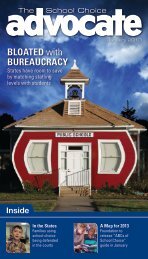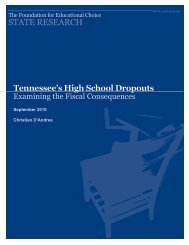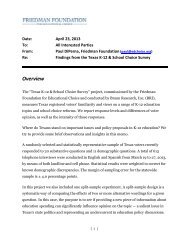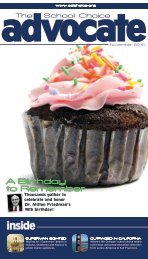Survey Memo - The Friedman Foundation For Educational Choice
Survey Memo - The Friedman Foundation For Educational Choice
Survey Memo - The Friedman Foundation For Educational Choice
Create successful ePaper yourself
Turn your PDF publications into a flip-book with our unique Google optimized e-Paper software.
Date: June 5, 2012<br />
To:<br />
All Interested Parties<br />
From:<br />
RE:<br />
Paul DiPerna<br />
Findings from the Tennessee K-12 & School <strong>Choice</strong> <strong>Survey</strong><br />
Overview<br />
<strong>The</strong> “Tennessee K-12 & School <strong>Choice</strong> <strong>Survey</strong>” project, commissioned by the <strong>Friedman</strong><br />
<strong>Foundation</strong> for <strong>Educational</strong> <strong>Choice</strong> and conducted by Braun Research Inc. (BRI),<br />
measures Tennessee registered voters’ familiarity and views on a range of K-12 education<br />
topics and school choice reforms. We report response levels and differences (using the<br />
term “net score” or “net”) of voter opinion, and the intensity of responses.<br />
Where do Tennesseans stand on important issues and policy proposals in K-12 education?<br />
We try to provide some observations and insights in this paper.<br />
A randomly selected and statistically representative sample of Tennessee voters recently<br />
responded to 17 substantive questions and 11 demographic questions (see pages 49 – 76).<br />
<strong>The</strong> next section summarizes our key findings.<br />
A total of 606 telephone interviews were conducted in English from February 11 to 21,<br />
2012, by means of both landline and cell phone. Statistical results were weighted to<br />
correct known demographic discrepancies. <strong>The</strong> margin of sampling error for the<br />
statewide sample is ± 4.0 percentage points.<br />
In this project we included five split-sample experiments. A split-sample design is a<br />
systematic way of comparing the effects of two or more alternative wordings for a given<br />
question. <strong>The</strong> purpose is to see if particular wording, or providing a new piece of information,<br />
can significantly influence opinion on a given topic. <strong>For</strong> this survey, we were particularly<br />
[ 1 ]
interested in how wording can affect responses to questions on taxes, education spending, and<br />
digital learning—all salient issues in Tennessee state politics and policy discussions.<br />
Our polling paper has four sections. <strong>The</strong> first section summarizes key findings. We call<br />
the second section “<strong>Survey</strong> Snapshots,” which offers charts highlighting the core<br />
findings of the project. <strong>The</strong> third section describes the survey’s methodology,<br />
summarizes response statistics, and presents additional technical information on call<br />
dispositions for landline and cell phone interviews. <strong>The</strong> fourth section presents our<br />
questionnaire and results (“topline numbers”), essentially allowing the reader to follow<br />
the actual interview as it was conducted, with respect to question wording and ordering.<br />
We set out to give a straight-forward analysis, going easy on editorial commentary, and<br />
letting the numbers and charts communicate the major findings.<br />
Key Findings:<br />
Nearly three of four registered voters in Tennessee (74%) are paying<br />
attention to issues in K-12 education. About one of four voter (25%)<br />
say they pay “very little” or no attention.<br />
See Question 1<br />
In the poll, Tennesseans who say they pay “a lot” of attention (44%) to K-12 education<br />
issues outnumber those who say they pay no attention (9%) by a nearly five-to-one ratio.<br />
Middle-age and older voters (ages 30 to 49, and 50 and older, respectively)<br />
clearly pay closer attention to these issues than younger voters. Almost half of<br />
the 30 and older voters (47%) are engaged on K-12 education issues, saying they<br />
pay “a lot” of attention. By comparison, about one-quarter of younger voters (age<br />
18 to 29) say the same.<br />
Tennesseans are less likely to think that K-12 education is heading in the<br />
“right direction” (36%) compared to being on the “wrong track” (50%).<br />
[ 2 ]
See Question 2<br />
Small town and rural voters (43% and 37%, respectively, say “right direction”) are<br />
more positive on this question than suburban voters (27%). Nearly 6 of 10<br />
suburban respondents (57%) said the state’s K-12 education system is on the<br />
“wrong track.”<br />
Age appears to correspond with educational outlook. Younger voters in the age<br />
groups 18 to 29 and 30 to 49 tend to be more optimistic (44% and 39%,<br />
respectively, say “right direction”) than older voters (31% say “right direction”).<br />
Tennessee voters are essentially split when assessing the state’s public<br />
school system (47% say “good” or “excellent”; 49% say “fair” or “poor”).<br />
See Question 3<br />
Urban voters are much more likely to give negative ratings (62%) and less likely to<br />
give positive ratings (35%) when compared to small town and rural voters. About<br />
half of voters in small towns and rural areas said the public school system is “good”<br />
or “excellent.” And roughly 44% of these voters gave ratings of “fair” or “poor.”<br />
Republican responses are significantly different than Independent responses. About<br />
half of self-identified Republicans (53%) gave positive ratings, which is greater than<br />
the proportion of Independents (41%) saying the same. Conversely, 44% of<br />
Republicans described the public school system as “fair” or “poor.” Nearly 6 of 10<br />
Independents (56%) gave these negative ratings.<br />
More than half of respondents (52%) from households earning less than $50,000<br />
offered positive ratings for the state’s public schools. Nearly 6 of 10 low-income<br />
respondents (58%) said “good” or “excellent.” On the other hand, households<br />
earning $50,000 or more were less positive (44%).<br />
Based on survey responses, Tennessee voters do not know how much<br />
is spent per student in public schools. <strong>The</strong>re is an awareness gap.<br />
[ 3 ]
See Question 4<br />
Approximately $7,992 is spent on each student in Tennessee’s public schools, and<br />
25% of respondents could estimate the correct per-student spending range for the<br />
state (this dollar figure reflects “current expenditures” per student). Nearly onethird<br />
of all respondents (31%) thought that less than$4,000 is being spent per<br />
student in the state’s public schools. Another 28% of voters said “don’t know” to<br />
the question and did not offer a spending number. 1<br />
When considering “total expenditures” per student ($8,894 in 2008-2009), which is<br />
another definition for educational spending, voter estimates look much more offtarget.<br />
Only 9% of voters estimated the “$8,001 to $12,000” spending range. Of the<br />
437 respondents who offered an estimate or guess to this question, almost eight of ten<br />
(78%) underestimated “total” educational spending per student.<br />
Tennessee’s spending estimates are slightly better when compared to other states<br />
where we have polled. But no matter how one defines expenditures (per student),<br />
voters are woefully uninformed about how money is spent in K-12 education.<br />
When given the latest per-student spending information, voters are<br />
less likely to say public school funding is at a level that is “too low,”<br />
compared to answering without having such information.<br />
See Questions 5A and 5B<br />
1<br />
“Current Expenditures” data include dollars spent on instruction, instruction-related support services,<br />
and other elementary/secondary current expenditures, but exclude expenditures on long-term debt service,<br />
facilities and construction, and other programs. “Total Expenditures” includes the latter categories.<br />
See Frank Johnson, Lei Zhou, and Nanae Nakamoto, Revenues and Expenditures for Public Elementary and<br />
Secondary Education: School Year 2008–09 (Fiscal Year 2009) (NCES 2011-329). U.S. Department of<br />
Education. Washington, D.C.: National Center for Education Statistics (June 2011).<br />
URL: nces.ed.gov/pubs2011/2011329.pdf<br />
[ 4 ]
We asked two slightly different questions about the level of public school funding in<br />
Tennessee. On version 5A, 55% of voters said that public school funding is “too low.”<br />
However on version 5B, which included a sentence referring to data on per-student<br />
funding in Tennessee ($7,992), the proportion of voters saying “too low” shrank by<br />
14 percentage points, effectively a 25% reduction.<br />
Tennesseans are likely to change their views on public school funding – at least<br />
when initially saying it is “too low” – if given accurate per-student spending<br />
information. <strong>The</strong> implication that opinion can turn on a single piece of data is<br />
important for political sound bites that focus on aggregate levels of public<br />
spending rather than how the money is allocated and spent per student.<br />
Pluralities of voters (about 4 of 10) would prefer taxes to “stay about the<br />
same,” rather than increase or decrease taxes to fund public schools. In<br />
a split-sample experiment, no statistically significant differences<br />
emerged among respondents favoring state taxes versus local taxes.<br />
See Questions 6A and 6B<br />
Considering the statewide sample, approximately 56% of voters want taxes to<br />
stay the same or decrease at both the state and local levels. Solid majorities of<br />
voters across nearly all demographic groups either support keeping taxes about<br />
the same or decreasing them.<br />
A respondent’s age does matter on this question. Middle-age voters are more<br />
likely to want tax increases at the state level (42%) and local level (42%),<br />
especially compared to younger voters on state taxes (21% want an increase) and<br />
older voters on local taxes (29% want an increase). Nearly 6 of 10 younger voters<br />
(58%) said they support an increase in local taxes.<br />
When asked for a preferred school type, equal proportions of Tennessee<br />
voters (40% each) would either first choose a regular public school or<br />
[ 5 ]
private school. Evidence points to a vast disconnect between voters’<br />
school preferences and actual enrollment patterns in the state.<br />
See Question 7<br />
A little more than 7% of Tennessee’s K-12 student population attends private<br />
schools, but in our survey interviews, 4 of 10 voters (40%) would select a private<br />
school as a first option. Approximately 92% of the state’s students attend regular<br />
public schools, but a much lower percentage of voters (40%) would choose a<br />
regular public school as their first choice. Roughly 4,600 students in the state<br />
attend charter schools (less than 1% of the state’s K-12 student population), but 9%<br />
of Tennessee voters would like to send their child to a charter school. About 8% of<br />
voters said he/she would opt to homeschool their child. <strong>The</strong> results suggest the<br />
capability to choose a preferred school is very limited in Tennessee.<br />
Our callers interviewed more than 200 parents of school-age children. Only 3 of<br />
10 parents (31%) said they would first choose a regular public school. About 44%<br />
of non-parents said they preferred a regular public school.<br />
Nearly half of Democrats (47%) chose a regular public school, and 4 of 10<br />
Independents (42%) indicated the same. Other demographic groups that stood out<br />
favoring regular public schools included younger voters (52%) and voters earning<br />
less than $50,000 (46%).<br />
Democrats were also more likely than Republicans and Independents to say they<br />
would choose a charter school. Middle-age and older voters were more likely than<br />
younger voters to prefer a charter school.<br />
Republicans and Independents were more likely to want to homeschool than<br />
Democrats. Whites were much more likely to choose the homeschool option when<br />
compared with African Americans.<br />
Nearly half of Republicans (49%) said they would first select a private school, a<br />
significantly different average response compared to Democrats (34%) and<br />
[ 6 ]
Independents (37%). Nearly half of respondents (47%) living in middle-income<br />
and high-income households chose a private school as first option. A significantly<br />
lower level of respondents (33%) in lower-income households (< $50,000)<br />
selected a private school.<br />
Roughly equal numbers of respondents in our survey prioritize a “better<br />
education” and “individual attention” (12% each impression) as the key<br />
attribute they are looking for in the selection of their preferred school.<br />
<strong>The</strong> next most important attribute, as suggested by 10% of all<br />
respondents, is “socialization” among other peer students and kids.<br />
See Question 8<br />
Some caution. <strong>The</strong>se characteristics appear to be a higher priority over others on the<br />
list. However, any of these qualities may or may not attract more urgency as a second<br />
or third priority, which we do not explore in our survey.<br />
Tennessee voters are much more likely to favor charter schools (61%),<br />
rather than oppose such schools (18%). <strong>The</strong> net support for charter<br />
schools is very large (+43 net percentage points).<br />
See Questions 9 and 10<br />
Tennessee registered a very large positive net score (+43 net) supporting charter<br />
schools. <strong>The</strong> enthusiasm is also quite positive (+14 intensity). In other words,<br />
voters are more likely to say they “strongly favor” charter schools (22%)<br />
compared to those who say they “strongly oppose” (8%).<br />
Charter schools enjoy majority support across all examined demographic groups.<br />
However, where a voter lives can point to some differences in support level. <strong>For</strong><br />
example, urban voters (73%) are much more favorable toward charter schools<br />
than voters living in small towns (58%) and rural areas (59%).<br />
[ 7 ]
Democrats and Republicans differ as well. Republicans (67%) are more<br />
supportive of charter schools than Democrats (58%), and Republicans (15%) are<br />
less likely to oppose charters than Democrats (23%).<br />
Intensity of support for charters is greatest among parents, urban voters,<br />
Republicans, and households earning $75,000 or more. <strong>The</strong>re is relatively<br />
weaker intensity (but still positive) among younger voters (age 18 to 29) and lowincome<br />
households earning less than $25,000.<br />
About one of three voters (33%) say they are at least “somewhat familiar” with charter<br />
schools, which is similar awareness compared to what we have seen in other states.<br />
<strong>The</strong>re may be opportunity to grow support for charter schools. Although only<br />
one-third of voters say they are familiar with charters, the potential voter support<br />
for a “charter school” probably could expand if the policy idea is better<br />
understood. <strong>The</strong> association between charter school familiarity and favorability<br />
is positive in direction and moderate in size (r=.270, p < .01).<br />
Depending on terminology, voters appear to marginally shift their<br />
views on virtual/online schools. In a split-sample experiment, we<br />
asked identical questions, but alternated the terms “virtual school”<br />
and “online school.”<br />
See Questions 11, 12A, 12B<br />
When using “virtual school” in question 12A, a majority opposes the concept<br />
(55% oppose; -22 net). On the other hand, when using the term “online school,”<br />
a similar plurality supports the concept (51% oppose; -14 net).<br />
In this data, we provide some caution for virtual/online school advocates. On either<br />
question nearly 3 of 10 voters hold strongly negative views on virtual/online schools,<br />
as defined in this questionnaire (12A: 29% “strongly oppose”; 12B: 27% “strongly<br />
oppose”). <strong>The</strong> intensity on either split question is currently negative (-18 intensity<br />
for 12A; -13 intensity for 12B).<br />
[ 8 ]
However, there may be opportunity to grow support for “virtual schools.”<br />
Approximately 30% of voters say they are familiar with “virtual schools.” <strong>The</strong><br />
association between virtual school familiarity and favorability is positive in<br />
direction and moderate in size (r=.370, p < .01).<br />
Likewise, the same can be suggested for educating and building support for<br />
“online schools.” <strong>The</strong> same proportion of voters say they are familiar with online<br />
schools. <strong>The</strong> association between online school familiarity and favorability is<br />
positive in direction and moderate in size (r=.283, p < .01).<br />
Tennesseans clearly support “tax-credit scholarships.” <strong>The</strong><br />
percentage of those who favor (61% or 69%, depending on the<br />
question version) is more than double the number of people who say<br />
they oppose the policy (26% and 20%). No matter the wording of the<br />
question, we measure very positive reactions (+35 net and +49 net).<br />
See Questions 13A and 13B<br />
Based on our split-sample experiment results, it appears adding definition and<br />
context for voters will likely boost support for tax-credit scholarships (by eight<br />
percentage points, from 61% to 69%). <strong>The</strong> additional wording in question 13B<br />
also affects some demographic groups, such as Republicans (67% to 80% favor)<br />
and middle-age voters (58% to 82% favor). No matter the extra wording, older<br />
voters are more negative than other demographic groups – nearly three of ten say<br />
they are opposed to tax-credit scholarships.<br />
<strong>The</strong>re is majority support across all examined demographic groups. That said, a<br />
stark difference emerges among generations of voters. Almost three-fourths of<br />
younger and middle-age voters (73%) support tax-credit scholarships, compared<br />
with a substantially lower proportion of older voters (55%).<br />
Tennessee voters support an “education savings account” system<br />
(called an “ESA”). <strong>The</strong> percentage of those who favor ESAs (56%) is<br />
[ 9 ]
much larger than the proportion who say they oppose (31%) the policy.<br />
<strong>The</strong> net score is large (+25 net) with some enthusiasm (+12 intensity).<br />
See Question 14<br />
Majorities support ESAs across nearly all examined demographics. Net support<br />
is highest among parents (+35 net), young voters (+42 net), middle-age voters<br />
(+36 net), low-income voters (+35 net), and African Americans (+43 net). Older<br />
voters are least inclined to support ESAs (+8 net). Enthusiasm for this kind of<br />
policy is highest among parents (+24 intensity), young voters (+25 intensity),<br />
low-income voters (+24 intensity), and African Americans (+25 intensity).<br />
Once again, age does matter on this policy question. Young and middle-age voters<br />
show strong support for ESAs (66% and 62%, respectively), but older voters are<br />
significantly less favorable (47%). Conversely, older voters (39%) are more apt to<br />
oppose ESAs than young and middle-age voters (24% and 5%, respectively).<br />
Six of 10 Tennessee voters (59%) support school vouchers, compared<br />
to 31% of voters who say they oppose such a school choice system.<br />
<strong>The</strong> margin of support is considerable – 28 percentage points.<br />
See Questions 15, 16, and 17<br />
Majorities of support appear for all examined demographic groups. <strong>The</strong> levels of<br />
support for vouchers vary a bit among groups, but with the exception of older<br />
voters, net favorability is in the double digits.<br />
Net support for school vouchers is highest among parents (+46 net), urban voters<br />
(+45 net), Republicans (+36 net), young voters (+40 net), middle-age voters (+36<br />
net), low-income voters (+46 net), and African Americans (+58 net). Those<br />
groups significantly less inclined to support vouchers are non-parents (+19 net),<br />
rural voters (+17 net), Independents (+20 net), and older voters (+18 net).<br />
[ 10 ]
Enthusiasm for this kind of policy is highest among parents (+27 intensity), urban<br />
voters (+23 intensity), Republicans (+24 intensity), young and middle-age voters (+19<br />
intensity), low-income voters (+30 intensity), and African Americans (+30 intensity).<br />
Some demographic differences appear based on community type and age. Urban<br />
(69%) and small town (61%) voters are more likely to support school vouchers<br />
than rural voters (52%). A similar contrast in support levels exists between<br />
young (68%) and middle-age (62%) voters compared to older voters (54%).<br />
Conversely, older voters (36%) are significantly more likely to oppose school<br />
vouchers compared to young and middle-age voters (27%).<br />
When comparing school choice policy ideas, the enthusiasm for school vouchers<br />
(+11 intensity) is roughly the same as detected for charter schools (+14 intensity)<br />
and ESAs (+12 intensity), and less than tax-credit scholarships (+20 intensity).<br />
In a follow-up and open-ended question, we asked for the reason why a<br />
respondent chose his/her view regarding school vouchers. Most frequently,<br />
he/she would say “choice,” “freedom,” or “flexibility.” Approximately 23% of<br />
voters offered one of these similar terms.<br />
Nearly 4 of 10 voters (38%) say they are at least “somewhat familiar” with school<br />
vouchers, about average awareness compared to what we have seen in other states.<br />
<strong>The</strong>re is potential to broaden awareness and marginally expand support for<br />
school vouchers. <strong>The</strong> association between school voucher familiarity and<br />
favorability is positive in direction, but modest in size (r=.186, p < .01).<br />
[ 11 ]
<strong>Survey</strong> Project & Profile<br />
Title:<br />
<strong>Survey</strong> Organization:<br />
<strong>Survey</strong> Sponsor:<br />
Release Partner:<br />
Tennessee K-12 & School <strong>Choice</strong> <strong>Survey</strong><br />
Braun Research Incorporated (BRI)<br />
<strong>The</strong> <strong>Friedman</strong> <strong>Foundation</strong> for <strong>Educational</strong> <strong>Choice</strong><br />
Beacon Center of Tennessee<br />
Interview Dates: February 11 to 21, 2012<br />
Interview Method:<br />
Interview Length:<br />
Language(s):<br />
Sample Frame:<br />
Sampling Method:<br />
Live Telephone | 70% landline and 30% cell phone<br />
12 minutes (average)<br />
English<br />
Registered Voters<br />
Dual Frame; Probability Sampling; Random Digit Dial (RDD)<br />
Sample Size: TENNESSEE = 606<br />
Split Sample Sizes: “Split A” = 303; “Split B” = 303<br />
Margins of Error:<br />
TENNESSEE = ± 4.0 percentage points<br />
Each Split Sample = ± 5.6 percentage points<br />
Response Rates: Landline (LL) = 17.5%<br />
Cell Phone = 19.6%<br />
Weighting?<br />
Oversampling?<br />
Yes (Age, Gender, Race, and Hispanic origin)<br />
No<br />
Project Contact:<br />
Paul DiPerna | Research Director |paul@edchoice.org<br />
[ 12 ]


